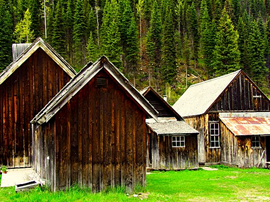Harl
‘Harl’, also known as ‘harling’ (or lime harling), is a technique for weatherproofing the exterior of masonry buildings, traditional to Scotland and Northern Ireland. It is commonly found on Scottish castles as well as more common building types, and was favoured due to its practicality and suitability for the harsh, wet climate.
The term ‘harling’ derives from the action of hurling wet mortar at a solid wall. This is known as a ‘cast-on’ finish, as opposed to a floated base coat (traditional to England), or rough-cast work such as pebbledash. In Ireland, it is commonly known as ‘wet dash’.
Harling consists of a slaked lime and coarse aggregate mortar which is thrown onto a stone wall, using a slurry of small pebbles or fine stone chips. By embedding a pigment in this material, the need for repainting can be avoided. A specially-shaped trowel is used to throw and then press the material into the surface. Cast-on coatings tend to provide better resistance to weather as the mortar is better compacted and more uniform throughout its thickness compared to trowelled-on coatings.
As the harl is mostly lime render it cures chemically rather than by drying, to provide a weather-protective and decorative coating. Once the harl is set it can be lime washed in various colours.
Short Guide: Climate Change Adaptation for Traditional Buildings, published on 10 July 2017 by Historic Scotland, defines harl as a: ‘Scottish form of roughcast in which the mixture of the aggregate (small even-sized pebbles) and binding material (traditionally sand and lime) is cast onto a masonry wall. In traditional harls the aggregate is within the mix (wet dash), in non-traditional 20th century harls the aggregate is dashed on separately (dry dash).’
[edit] Related articles on Designing Buildings
IHBC NewsBlog
IHBC Context 183 Wellbeing and Heritage published
The issue explores issues at the intersection of heritage and wellbeing.
SAVE celebrates 50 years of campaigning 1975-2025
SAVE Britain’s Heritage has announced events across the country to celebrate bringing new life to remarkable buildings.
IHBC Annual School 2025 - Shrewsbury 12-14 June
Themed Heritage in Context – Value: Plan: Change, join in-person or online.
200th Anniversary Celebration of the Modern Railway Planned
The Stockton & Darlington Railway opened on September 27, 1825.
Competence Framework Launched for Sustainability in the Built Environment
The Construction Industry Council (CIC) and the Edge have jointly published the framework.
Historic England Launches Wellbeing Strategy for Heritage
Whether through visiting, volunteering, learning or creative practice, engaging with heritage can strengthen confidence, resilience, hope and social connections.
National Trust for Canada’s Review of 2024
Great Saves & Worst Losses Highlighted
IHBC's SelfStarter Website Undergoes Refresh
New updates and resources for emerging conservation professionals.
‘Behind the Scenes’ podcast on St. Pauls Cathedral Published
Experience the inside track on one of the world’s best known places of worship and visitor attractions.
National Audit Office (NAO) says Government building maintenance backlog is at least £49 billion
The public spending watchdog will need to consider the best way to manage its assets to bring property condition to a satisfactory level.
















